Some of the caterpillars that are easy to spot are white. You can find these caterpillars in various areas around North America.
Many white caterpillars are common in Eastern and Southern states.
They can be white throughout their caterpillar stage or they can only be white in a particular growth stage, known as an instar.
They go through multiple instars before becoming adult moths or butterflies.
Host plants and trees are the only areas where these white caterpillars can be found.
They are either seen individually or in groups, mainly on the underside of leaves.
White caterpillars can be diurnal or nocturnal. All caterpillars feed, which isn’t the case with all adults.
At least 1 brood of caterpillars is born per species. Some species living in tropical or subtropical climates can have 2-3 broods per year.
Table of Contents
Are White Caterpillars Poisonous?
White caterpillars are largely not poisonous and non-venomous. They pose no threat to humans or animals.
However, many species of white caterpillars can trigger skin reactions such as redness, itchiness, or even prolonged periods of rashes or dermatitis.
Puss caterpillars are among the most common species that have venomous glands connected to their long hairs.
These venomous glands can trigger various skin-level allergies in humans.
Other types of caterpillars are known to sting. This can also cause skin irritation and even be a reason to avoid touching caterpillars altogether.
Species found in parks and woodlands, such as Black-waved Flannel Moth caterpillars, are known to sting and cause skin irritation.
Types of White Caterpillars
The following species of white caterpillars are highly common in US and Canada.
1. Yellow Bear Caterpillar
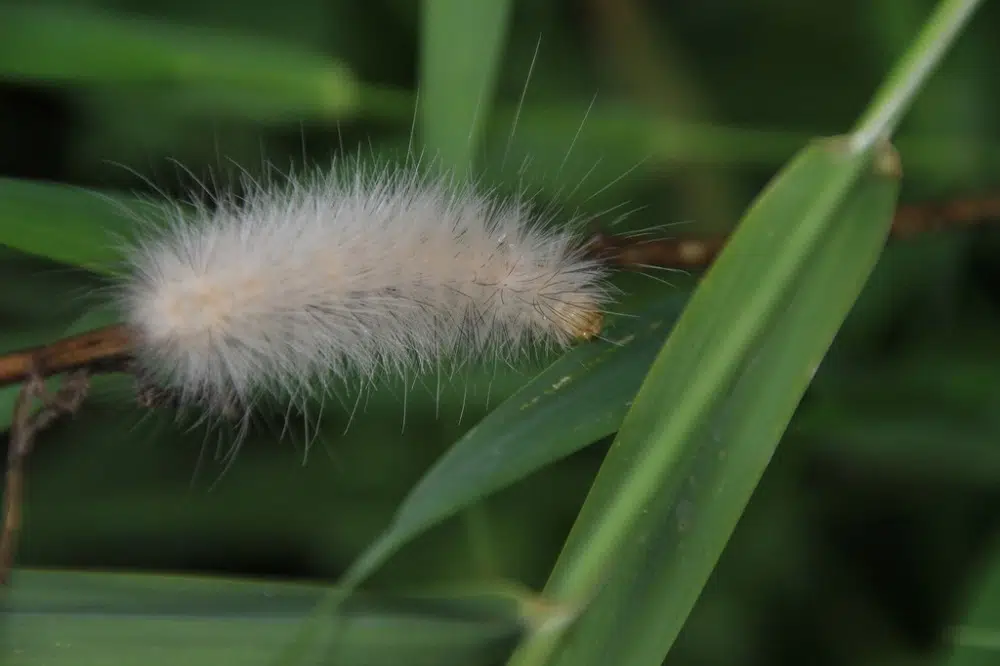
These types of caterpillars (Spilosoma virginica) are known to come in different colors through instars, including white.
They can also be yellow or brown.
Characterized by a hair-covered body, the caterpillar is known for moving host plants frequently.
You can see these caterpillars in the warm summer months and the fall before they overwinter.
2 to 3 broods per year are seen with the species.
Yellow Bear or Yellow Wooly Bear caterpillars are most common on hemp, short grasses, and clover.
The damages of Yellow Bear caterpillars to crops are considerable.
They eat entire plant leaves except for the thicker veins of the leaf in a process known as skeletonization.
This leads to sick host species may also die in case of large invasions.
2. White-tipped Ctenucha Caterpillar
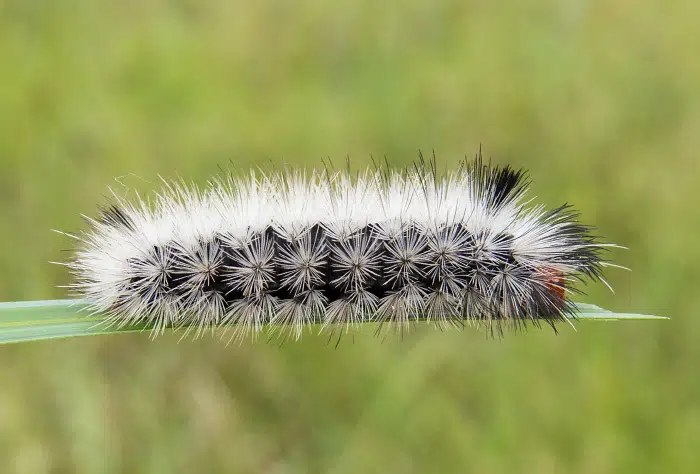
This caterpillar (Ctenucha rubroscapus) is native to Western regions of North America. It can be found in California, Nevada, Oregon, and Washington state.
Caterpillars of this genus have black bodies with white hairs. The white hair covers the body completely.
Only one brood of White-tipped Ctenucha caterpillars is seen per year.
You’re most likely to see the species in mid-summer, around July.
Caterpillars of this genus feed on grasses.
Sedges are among the most common hosts of the species.
3. Hickory Tussock Moth Caterpillar
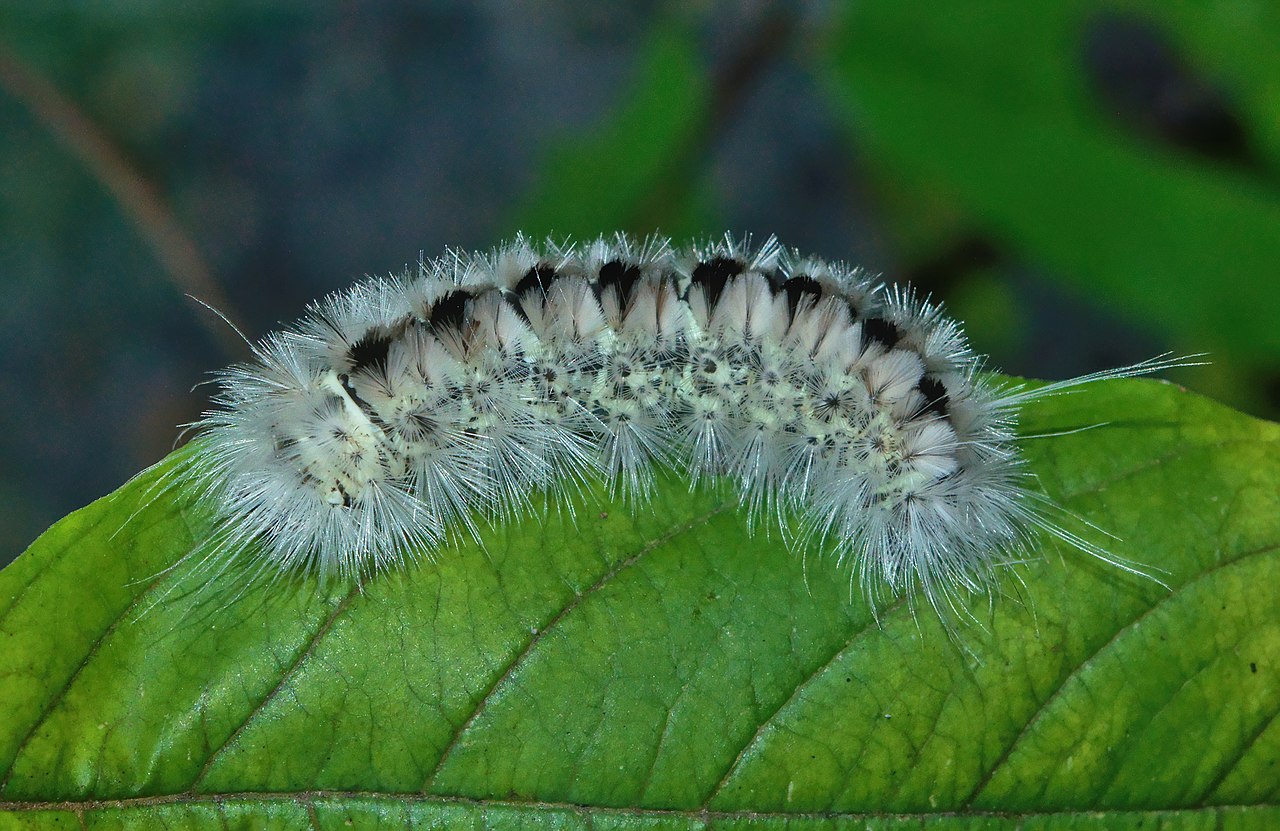
This moth species (Lophocampa caryae) is known for its long white hair.
Only one generation of Hickory Tussock Moth caterpillars is born per year.
Native to Northeastern US territories, this species initially begins life as a hairless white caterpillar.
Multiple small caterpillars can be seen in groups, on the underside of hickory leaves. Some moths might also be found alone as they can live solitary lives.
As they grow, these caterpillars start to show their long barbed white hairs with a few black marks on the dorsum.
These white hairs eventually take over the entire body of the moth, mainly for defensive purposes.
It has long been believed this caterpillar is venomous.
Evidence of venom in the species is yet to be concluded. However, handling these caterpillars leads to dermatitis in humans.
As its name suggests, the species lives on hickory. It’s also present on an extended range of trees such as elm, ash, or maple.
4. Puss Caterpillar

Puss Caterpillars (Megalopyge opercularis) are some of the most common species in Florida. These are poisonous caterpillars that trigger allergic reactions in humans.
Handling these caterpillars isn’t recommended as they have venom glands connected to their hairs.
The name of the species is inspired by its hairy body, similar to hairy cats.
The white and brown color is specific to this species.
Like many types of hairy caterpillars, Puss caterpillars are commonly found on trees.
Oak tree leaves are among the favorite leaves of the species.
Elm, oak, and maple are also trees that can be hosts for these poisonous hairy caterpillars.
Fruit trees might also be a temporary host for Puss caterpillars in North America. Apple trees are among the common hosts of the species.
You can even find puss caterpillars in your garden or around the house on roses.
5. Maple Looper Moth Caterpillar
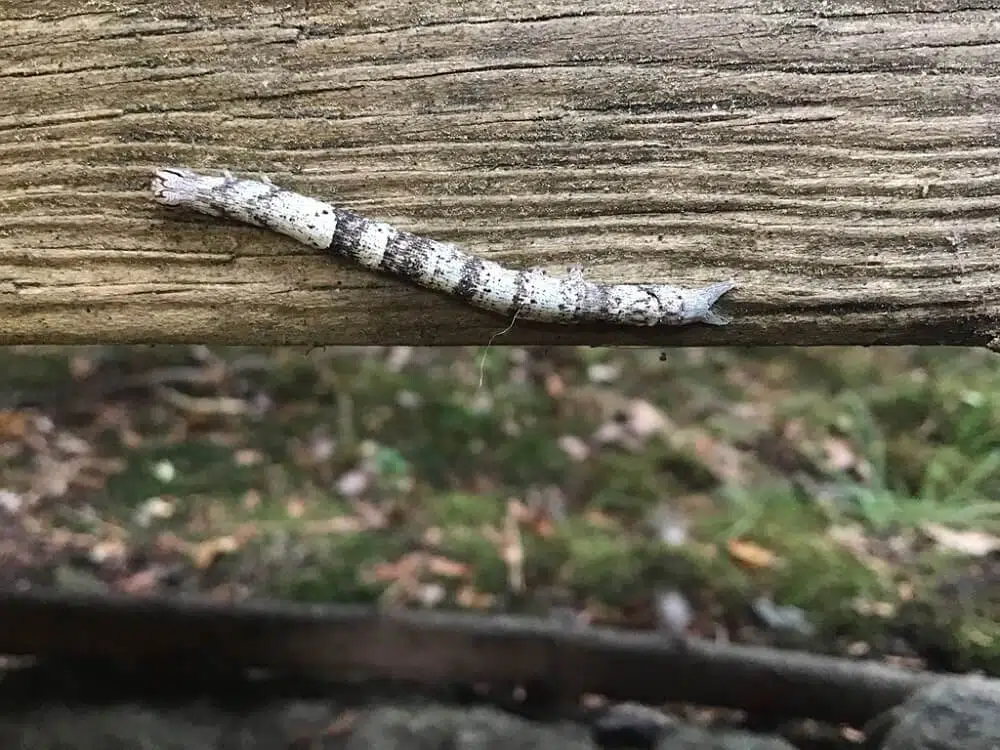
The Maple Looper Moth Caterpillar (Parallelia bistriaris) goes through multiple instars, changing its colors as it matures.
With a size of up to 35mm, this caterpillar goes from white to dark brown.
The species is believed to mimic bird droppings through its elongated body, to keep predators away.
You can find this caterpillar on various trees such as maple and birch during the summer.
A single Maple Looper Moth caterpillar brood is seen each year.
The species is endemic to Eastern parts of North America.
As it matures, it turns towards a brown-gray color which is also seen in the adult moth.
6. Yellow-collared Scape Moth Caterpillar
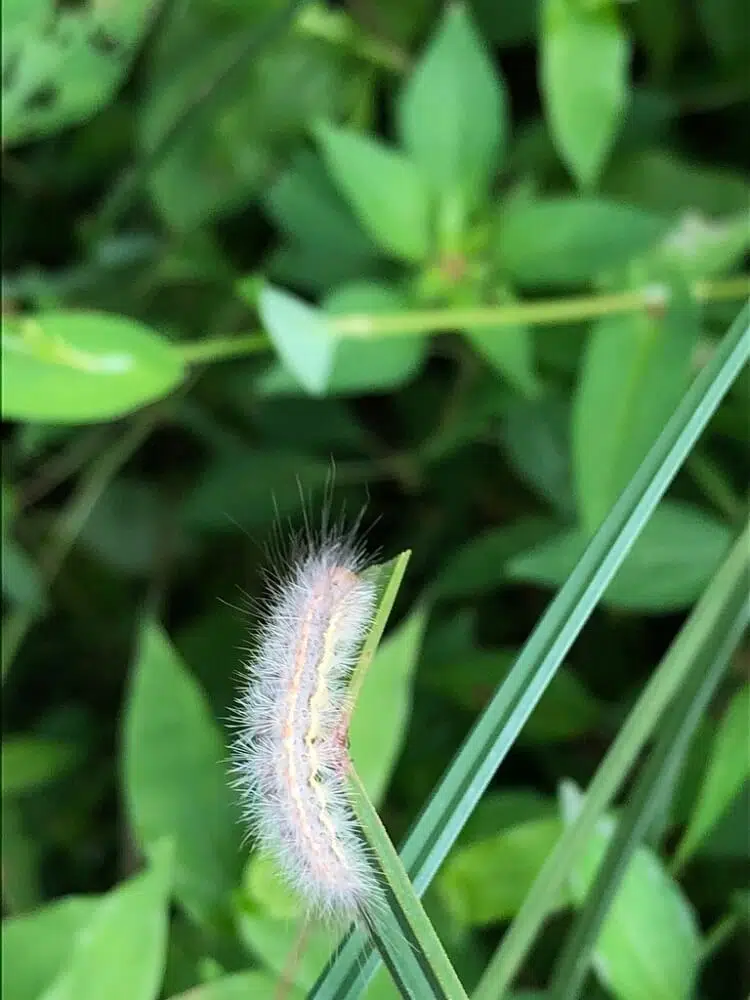
These caterpillars (Cisseps fulvicollis) begin life as white-haired species. One or multiple dark gray bands are seen across its body.
You can see this moth around the Eastern habitats of North America. It feeds on various types of grass and it also uses sedges as its hosts.
Multiple broods per year are characteristic of this species.
You can find these moths from spring to late summer before the adult moth emerges.
The Yellow-colored Scape moth is known to be a mimicking species. It takes on the appearance of wasps to keep predators away.
The caterpillar of the species is commonly confused with the Virginia Ctenucha caterpillar which is also white.
However, Virginia Ctenucha caterpillars mostly live in Northern US habitats while Yellow-collared Scape Moth caterpillars live both in the North and in the South.
7. Banded Tussock Moth Caterpillar

White Banded Tussock Moth Caterpillars (Halysidota tessellaris) are a common sight in Northern US territories.
This species feeds on various trees such as alder and chestnut.
Banded Tussock Moth caterpillars have a maximum size of up to 35mm. They have long white hairs and a few long black hairs along the body.
Off-white nuances are more specific to this species than pure white coloring.
You can find these caterpillars long into the season in their natural habitat. They can remain active until October-November.
In some cases, they might even survive until temperatures drop considerably to the freezing point. Areas near water are warmer and may host the species better in cold weather.
This is the reason Banded Tussock Moth caterpillars are also seen on willow.
8. Sycamore Tussock Moth Caterpillar

This species of moths (Halysidota harrisii) use American Sycamore trees as a host species.
Moths of this genus only appear in May each year. Their season is rather short as most moths of the species are gone by June and adult moths start to appear in July.
The damage the species creates in such a short amount of time to Sycamores is considerable.
Higher populations of Sycamore Tussock moths can even kill these trees.
Natural predators typically control the numbers of these moths.
Small birds eat them before they multiply considerably on trees.
However, chemical treatment is needed for Sycamores you might have at home.
Pesticides are used to keep these white hairy moths away from the host tree.
9. Delicate Cycnia Moth Caterpillar

This species of moth (Cycnia tenera) is known for having bad taste.
Absorbing the chemicals that make it have a bad taste starts in its caterpillar stage.
Delicate Cycnia Moth caterpillars have a white initial color which darkens within days. White cocoons cover the body of this species.
Caterpillars of the species are a common sight on dogbane. They can completely kill their host plant as female Delicate Cycnia Moths lay up to 100 eggs at a time.
This species can also damage dogbane by the amount of time it takes for its broods to grow. Each year, these caterpillars feed on dogbane late in the season, up to November.
They grow to a size of at least 30mm.
10. American Dagger Caterpillar

This caterpillar (Acronicta americana) has a white to white-yellow color and a black head. Long white hairs are specific to the species.
Multiple generations per year are seen across the United States, especially in Eastern states.
The broods of the species are influenced by the weather.
Those in the North are only seen in one brood per year while those in the South appear in 3 broods per year, up to November.
Caterpillars of this genus are known to cause skin irritation. While there’s no evidence of any type of venom glands, dermatitis is caused by the hairs of the caterpillar.
American Dagger Caterpillars are also some of the largest caterpillars in North America. They commonly reach a size of 50mm.
You may see these caterpillars on various trees. Maple, redbud, and hickory are among its most common hosts
11. Variable Tussock Moth Caterpillar
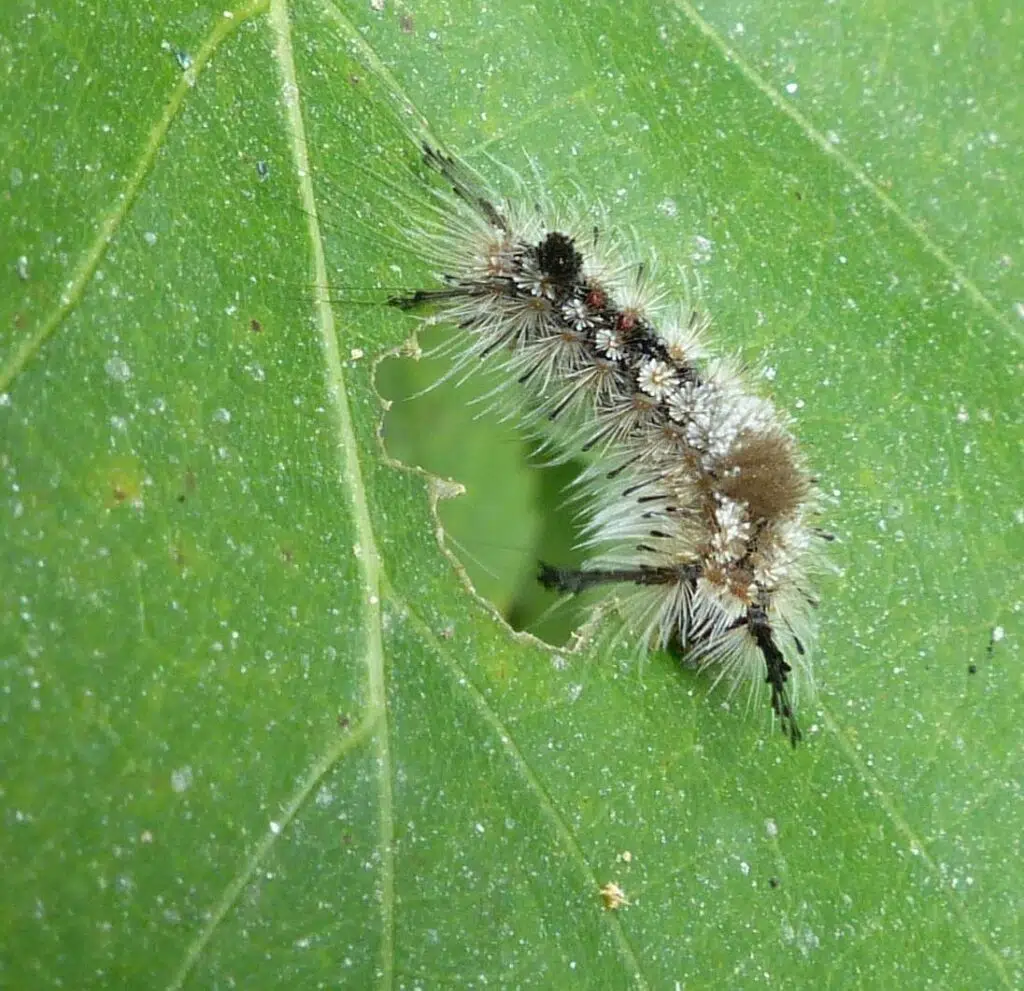
Variable Tussock Moth Caterpillars (Dasychira vagans) have white, black, and gray coloring.
The species shows a mix of long white hairs and alternating black hairs.
You might see these caterpillars in mixed hardwood forests. It can be found in the mixed forest where pine and hardwood trees grow together.
Found on a long list of North American trees, the Variable Tussock Moth caterpillar is mostly tied to oak trees.
Maple and birch are also viable host trees for this species that live in North American forests.
The caterpillar has also been reported in coastal areas where it may also grow on willows and other trees outside woodlands.
12. Red-bordered Metalmark Caterpillar
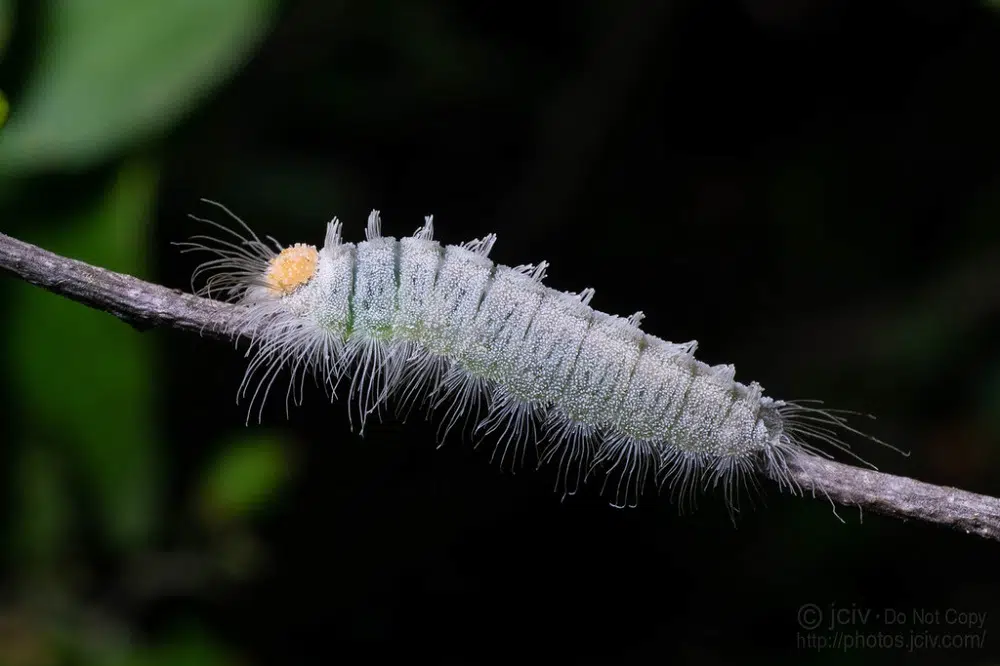
This species of caterpillars (Caria ino) are completely white. An elongated body with short white hairs is specific to Red-bordered Metalmark caterpillars.
Partially present in North America, Red-bordered Metalmark caterpillars are only seen in Southern parts of Texas.
Warm weather, a dry habitat, and the presence of the spiny hackberry shrub are what drive these caterpillars to this remote area of the US.
This small shrub provides the leaves the caterpillar feeds on as it grows.
Seen on the underside of the shrub’s leaves, the caterpillar eventually becomes an adult that exclusively feeds on flower nectar.
13. Rounded Metalmark Caterpillar
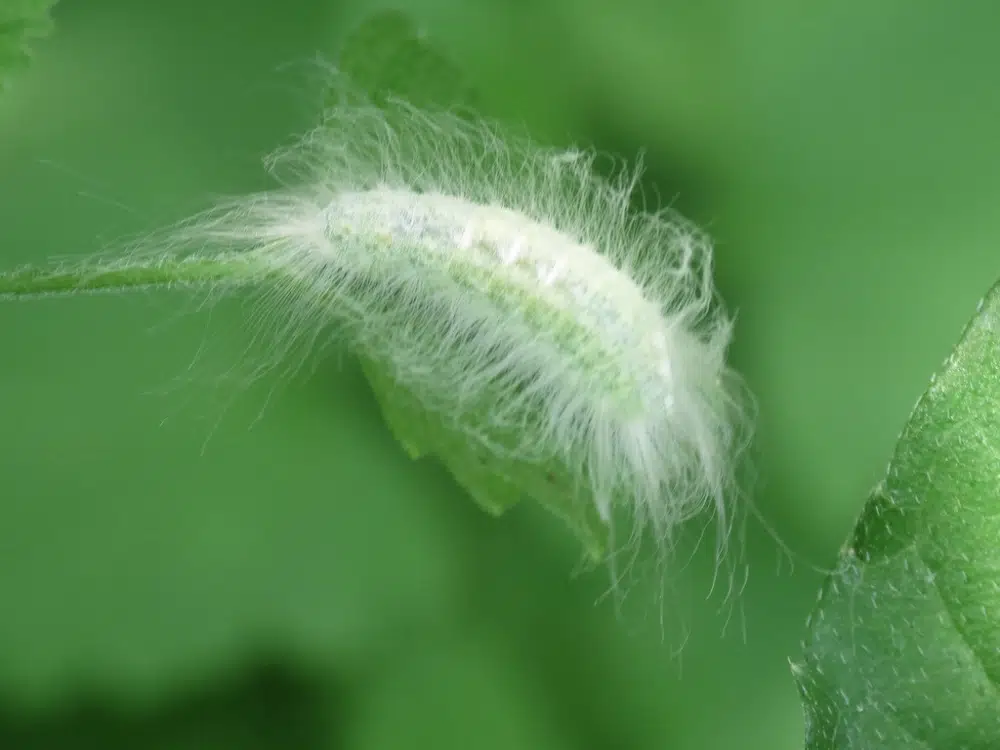
This caterpillar (Calephelis perditalis) is also only found in Texas within the US and in the Northern parts of Mexico.
The white coloring is specific to the species while adults have dark brown and black colors.
Southern and central parts of Texas are areas where you can find the species.
Habitats south of Austin are known to be areas where the Rounded Metalmark lives.
This caterpillar relies on wild plants in the sunflower family.
It’s a common sight on roadsides as well as in many other open areas.
Rounded Metalmark caterpillars turn into adults that feed on a wider range of flowers for nectar even outside the sunflower family.
14. Close-banded Yellowhorn Moth Caterpillar

Woodlands in the Northeastern parts of North America are common habitats for this caterpillar species (Colocasia propinquilinea).
This caterpillar goes through different physical changes from one instar to another.
It remains a white caterpillar but additional colors change. Its head turns brown from an initial red color.
Its white dorsum also starts to become slightly pink.
Black dots eventually appear on the dorsal side of the species within its last instar.
This species is reliant on oak trees and other deciduous trees in forested areas of the Northeastern United States and Southeastern Canada.
The species is most common in Pennsylvania.
15. Charadra dispulsa
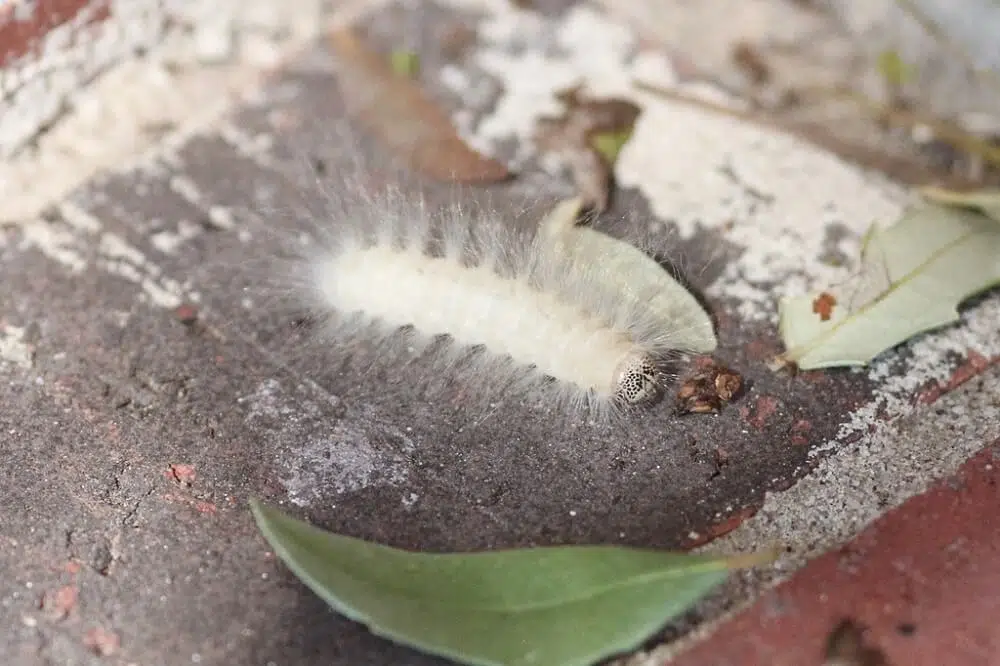
This species of moths are present in Southern areas of Texas. Areas South of San Antonio and Houston have the highest populations of the species, even if they can be found around the state.
Caterpillars of the species are rarely seen since they live further out from urban areas but are thought to use oak and other trees as hosts.
The species has a white to gray color which is also seen in the adult moth.
White and black colors are seen across the wings of the adult, together with gray sections.
You can see these moths from March in the state and Southwards in Mexico.
16. Little Metalmark Caterpillar
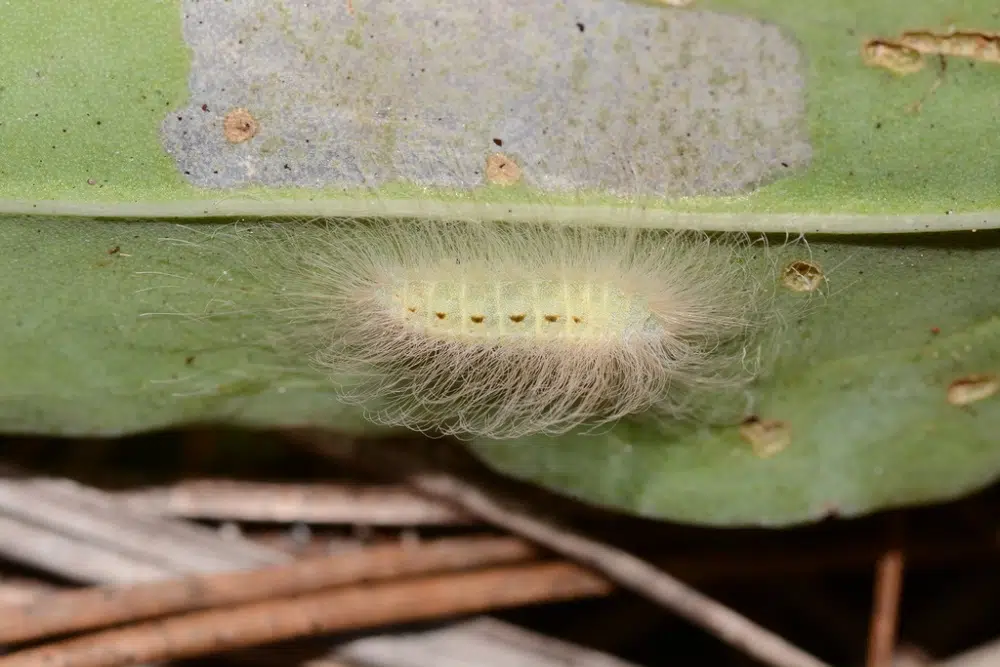
This species of caterpillars (Calephelis virginiensis) are mostly white, with green undertones.
Its segmented body is separated by pearl white bands. Sporadic white hairs are also seen across the body of the species.
The coloring of the caterpillar evolves from an initial all-green body seen in its first instar.
You can find Little Metalmark Caterpillars across various Southeastern US states. Most of these members of the species are scattered throughout Florida.
3 broods of Little Metalmark caterpillars are seen each year in the state.
Texas, South and North Carolina are other states where the caterpillar is common.
Yellow thistles and other thistles are some of the most common hosts of the species.
Adults feed on the nectar of various flowers. Yarrows are among the most common flowers adult Little Metalmark feed on.
17. Scarlet-bodied Wasp Moth Caterpillar
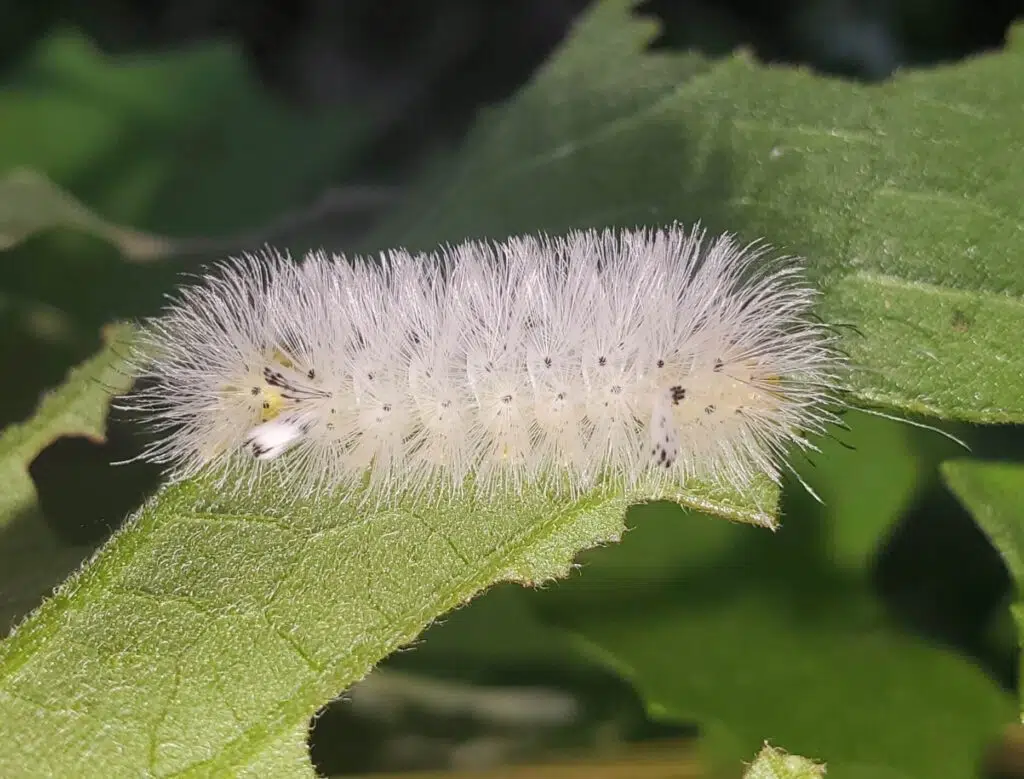
This common caterpillar (Cosmosoma myrodora) is seen across Florida in multiple broods.
White is its dominant color through the instars, which last at least 7 days but may last up to 2 weeks in certain circumstances.
The species is white and hairless in the first instar.
It then grows white hair with a few black hairs and yellow ventral coloring.
Florida Keys hempvine is one of the main reasons the caterpillar is seen in the state. This type of host plant provides the foundation for the red and black female wasp moth to lay eggs.
Larvae grow and feed on the plant until they fall to the ground after the last instar.
Tachninidae-family flies are the most common parasitoid of these caterpillars.
18. Spun Glass Slug Moth Caterpillar

This type of caterpillar (Isochaetes beutenmuelleri) is native to the US. It has a widespread Eastern US presence.
It can be found in habitats South of New York down to Florida and further out to Eastern Texas.
Oak and swamp oak are the common host trees of these white moths. Beech is a common host in a wide range of territories as well.
While the season of these caterpillars varies, the species is mostly seen in June, July, and August in most states.
Similar to a snowflake with hair growing in all directions, this species maintains some physical traits into adulthood.
A combination of white coloring with green undertones is specific to this caterpillar.
The Spun Glass Slug Moth also has hairs growing in different directions with a similar fuzzy look to its caterpillar.
19. Edwards’ Wasp Moth Caterpillar

Ficus plants are the most common hosts of Edwards’ Wasp Moth Caterpillars (Lymire edwardsii).
Off-white pale yellow colors are specific to this species. The color is almost uniform across the body.
Multiple white hairs cover the body of the species.
Just a few hairs are brown. A tuft of brown hair is seen on its mid-dorsum. This species also has a brown head.
This species is one of the most common pests to ficus trees in the US.
Ficus trees in Florida are often considerably impacted by Edwards’ Wasp moth caterpillar.
These caterpillars can defoliate a large percentage of tree leaves, with the potential of killing trees.
Biological pesticides are used to save ficus trees affected by these caterpillars.
Natural enemies might also reduce the number of caterpillars on these trees.
Tachinid flies are among the most common predators of the species.
20. Fall Webworm Caterpillar

Fall Webworm Caterpillars (Hyphantria cunea) are some of the most common white caterpillars in North America and around the world.
A long list of host plants makes this caterpillar one of the most common in popular culture.
Hundreds of trees have been proven to be suitable hosts for these white long caterpillars.
The species has a mostly white body with just a few tiny oranges and black spots on its body. This coloring is independent of its host trees.
Some of the most nutritious trees with soft leaves are chosen by the species as a host.
Elm and hickory are among the most common host trees for the caterpillar in North America.
The species doesn’t exclude fruit trees from its preferred hosts.
21. Spotted Apatelodes Caterpillar

Spotted Apatelodes Caterpillars (Apatelodes torrefacta) are a common sight in North America, especially in Eastern habitats.
This species has a pure white color in its first instars. It turns yellow within a few days, just before the last instar.
This species is covered in long white hair.
Caterpillars of this species are specifically known for using deciduous trees as their hosts.
They’re a common sight on oak leaves as well as on maple tree leaves.
Fruit trees are also a common host for the species.
These caterpillars are sometimes spotted on plum trees.
22. White-Marked Tussock Furry Horned Caterpillar

This moth (Orgyia leucostigma) has an atypical look as it has defensive glands on its body. These glands are white, much like its white hairs.
Black hairs or tufts are seen across its body as well.
The head of the species is red.
Caterpillars of this genus are among the few North American species that use both coniferous trees and deciduous trees as hosts.
It can grow on fir as it can also grow on hackberry and even on cherry trees.
Almost complete tree defoliation is common in the case of a large invasion within the species.
Fungus and birds are among the most common predators of these species and the main reasons an outbreak normally ends before a tree is defoliated.
23. Planthopper Parasite Moth Caterpillar
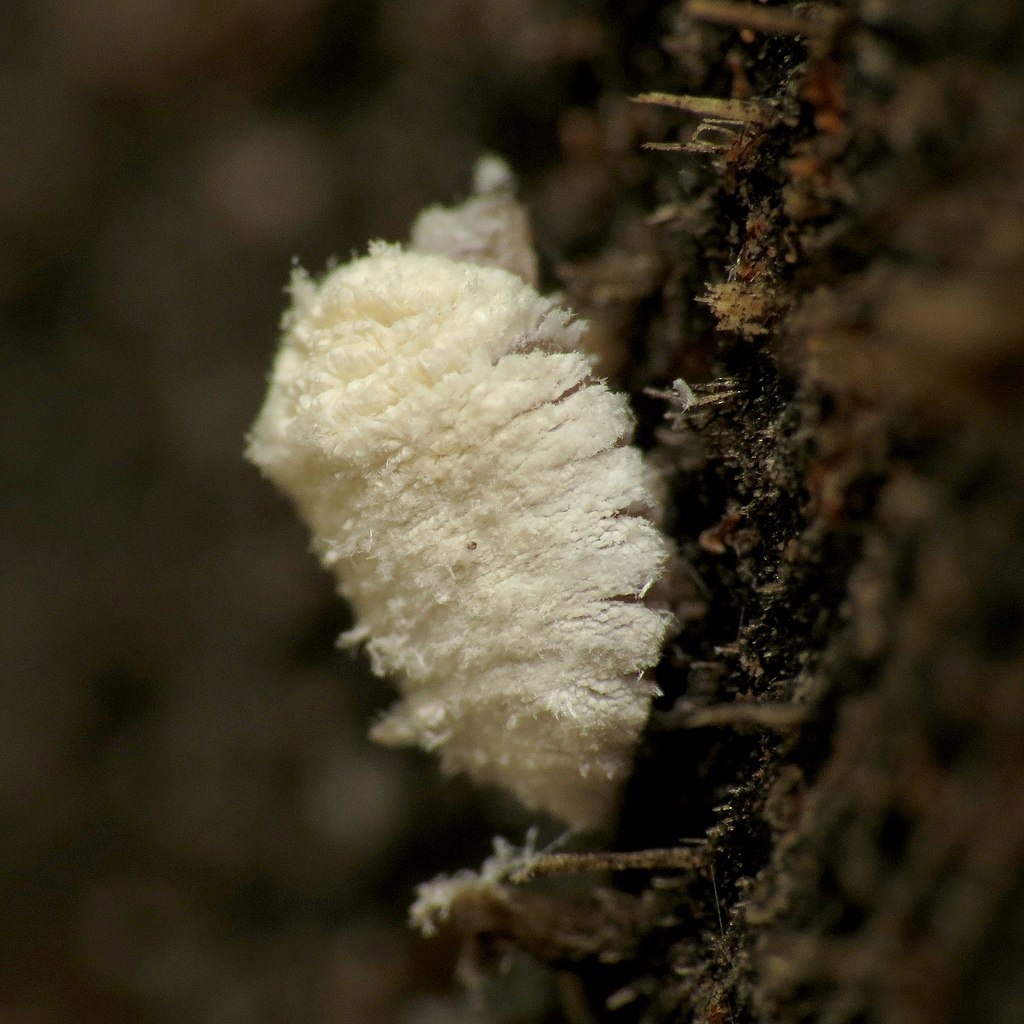
This species of caterpillars (Fulgoraecia exigua) have a pure white body covered in short fur-like hairs.
It represents one of the few white caterpillars that doesn’t feed on plant leaves as it prefers to eat small insects.
Planthoppers are the main food source for the species.
The caterpillar sucks fluids out of these planthoppers for nutrition.
Life starts in the first instar for these caterpillars which are a parasite of small planthoppers.
They chew through the soft abdomen of these insects for fluids.
Plathopper Parasite Moth caterpillars are native to North and Central America.
A reduced habitat is specific to this species within the US. It can only be found in Southern areas of Texas and New Mexico.
The species is also found in Southern California and Southern Arizona, but to a lesser extent.
24. Spiny Oak-slug Moth Caterpillar
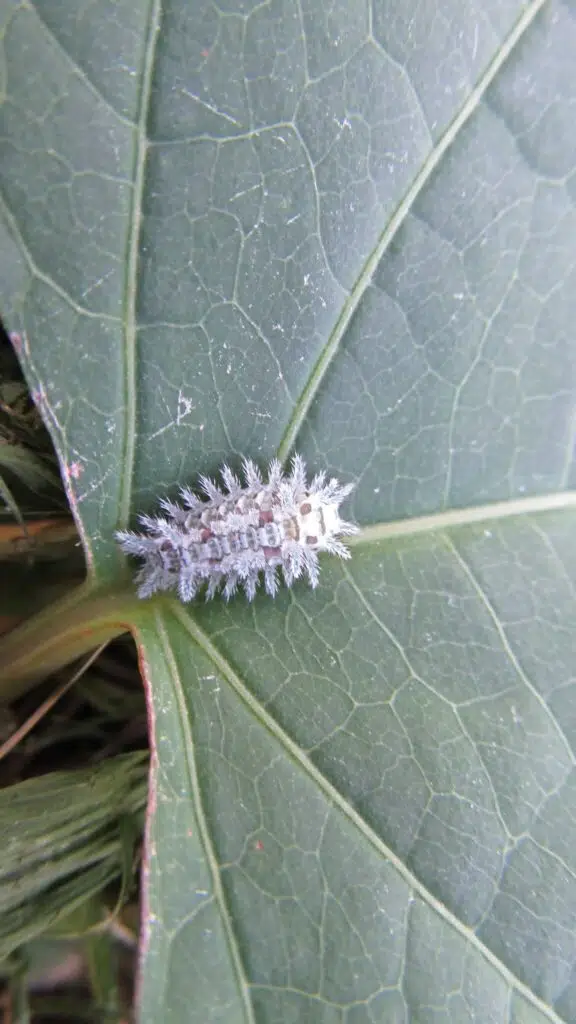
White, white-gray, white-yellow, green, and orange are common colors for the Spiny Oak-slug Moth Caterpillar (Euclea delphinii).
The species is widespread across North America. Still, it’s only present in small groups across these locations.
Various tree species including oak are the host of the Spiny Oak-slug Moth caterpillar.
Oak trees might be their preferred host, but these caterpillars are also seen on other hardwood trees and other fruit trees.
Maples are among the trees this species is seen on. Fruit trees such as plum and apple trees are secondary hosts.
25. Southern Tussock Moth Caterpillar

This caterpillar (Dasychira meridionalis) has a distinct short and wide body with long white hair.
Long antennae are specific to these caterpillars.
Orange and black tufts are specific to these caterpillars.
You can further distinguish Southern Tussock Moth caterpillars by the silk they spin around the leaves of their host.
A thick type of silk is specific to the caterpillar which protects it from small predators.
As the adult moth, the white caterpillar is nocturnal and almost impossible to spot during the day.
The caterpillar is active from late March to mid-July.
26. Large Tolype Moth Caterpillar
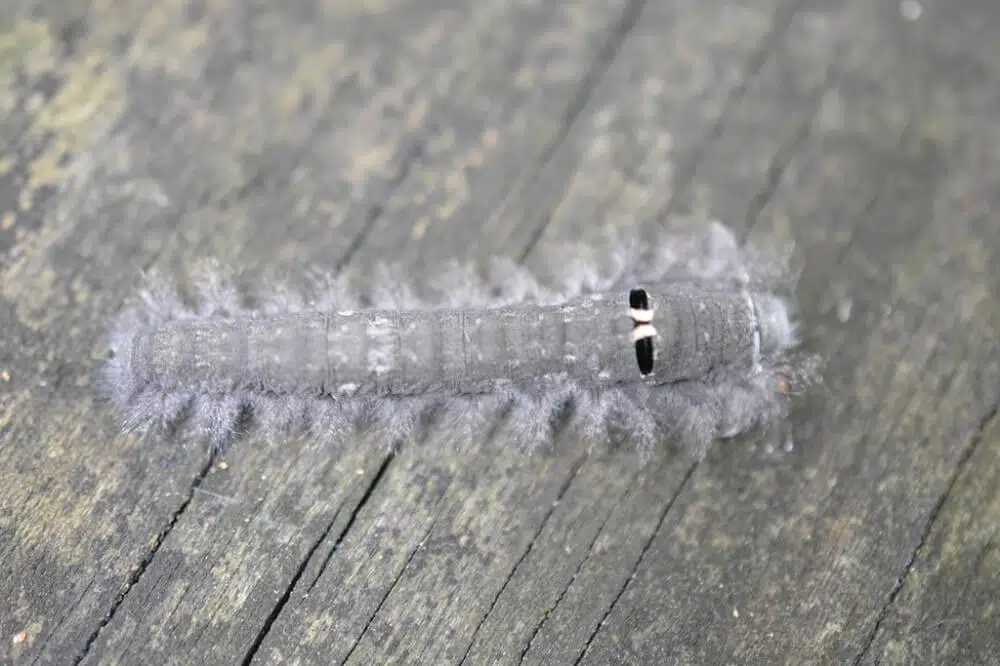
Native to Eastern US territories, the Large Tolype Moth Caterpillar (Tolype velleda) has a white-gray color.
This species is seen each year until July-August.
It has multiple shrubs, trees, and flowers it uses as hosts. Wild roses are among the most common host shrubs of the species.
Aspen and beech are also popular choices when it comes to feeding on tree leaves.
Linden is also one of the trees this moth can be seen on, particularly in parks.
27. Black-waved Flannel Moth Caterpillar
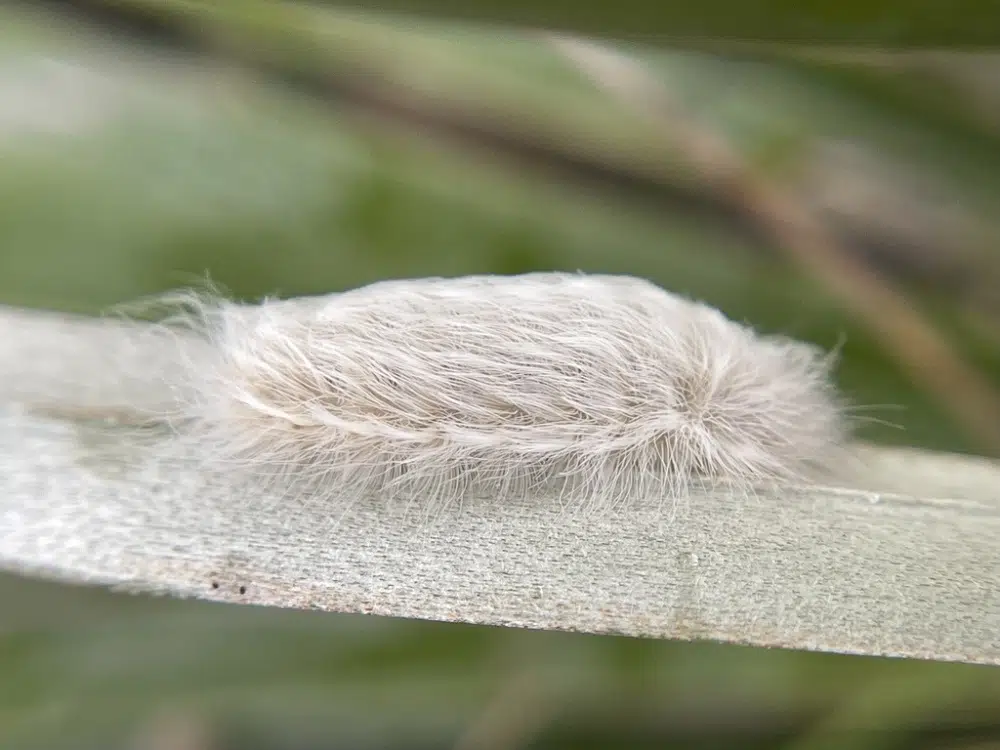
As adult moths, the Black-waved Flannel Caterpillar (Megalopyge crispata) has a white or cream-white color.
This color is specific to the species in all of its instars.
Most people know Black-waved Flannel Moth caterpillars as a species that bites, so they refrain from handling them.
Skin irritation is one of the first reactions to the sting of this caterpillar.
Most Black-waved Flannel Moths caterpillars are only found in deciduous forests.
They feed on trees and shrubs while the adult moth of the species doesn’t feed.
A long season is specific to these caterpillars. They’re active from May to October.